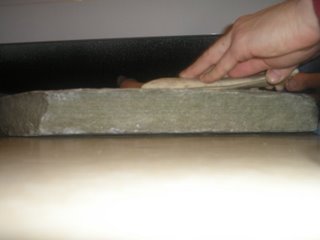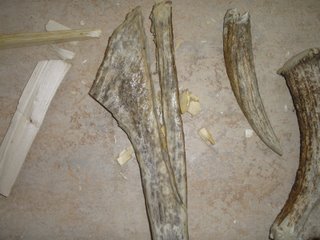The last half year or so, I have only used antler axes, no metal whatsoever. During this time I have made quite a few observations on them. Compared to stone axes, antler axes have mainly two advantages:
- Ease of construction (softer material, "axe shaped")
- Ease of repair (softer material, can be repaired by scraping with flakes)
Their major disadvantage is that they dull more quickly. On a newly sharpened antler and a stone axe, there is however no difference in sharpness. If there is, I would say it goes in the favour of the antler axe. Below: Flattening a piece with a diagonal antler axe.

There are primarily two styles of edges on these axes, the diagonal edge, the elk(US: moose) axe and the hafted slab. As antler normally has a pith, the first and third options are normally the only ones possible. That especially accounts for red deer antler, which has a very extensive pith.
The diagonally edged axe is quite quick to make. The fixed direction on the edge makes it very suitable for wood working, but not for heavy duty chopping. For small trees it works fine, but if you have to lean into the blow, you risk splitting or chipping the antler towards it's weakest direction, making repair a monumental task.

The elk axe is a much more stable axe, it is ground to a centered bevel like a standard metal axe and is therefore good for heavy duty chopping. This axe is as a general rule only possible to make out of elk antler, due to it being solid and extremely hard near the base. The superior weight of the elk antler also adds into the equation. Due to it's hardness and the sheer amounts of materials that needs to be removed, making this type of axe is a major undertaking. My elk axe is under remake, I will try to remember to post the appropriate pictures when it is finished.
The slab type I have limited experience with, I just made a quick one this fall and it didn't hold up for too long. This type lacks the weight of the former ones, but the narrow blade offers even greater precision and better cutting ability.
Hitting rocks is total death on bits, whether it is antler or stone, though even more so with stone. A way to avoid this is to make high stumps, that keeps the edge as far away from the ground and the rocks as possible.
The good ratio between hardness and flexibility is what makes antler such a good material for axes. Flexibility is completely lacking in stone and makes chipping more likely. However flexible, red deer antler (or degraded reindeer and elk antler) is on the margins of what is usable, it is too soft I feel and the extensive pith makes it prone to splitting. Use top grade reindeer or elk antler if you can get it. It is most likely that I will continue to use antler axes in the future, they arn't as good as metal, but then again nothing is.


.jpg)

.jpg)
.jpg)

.jpg)
.jpg)







































